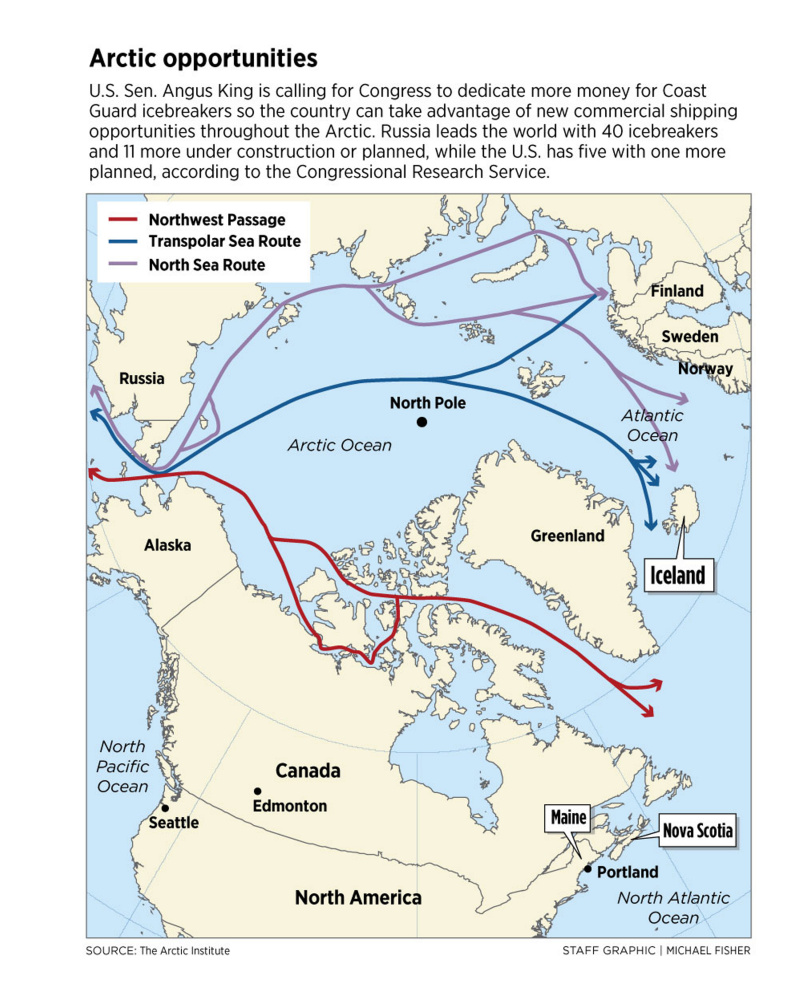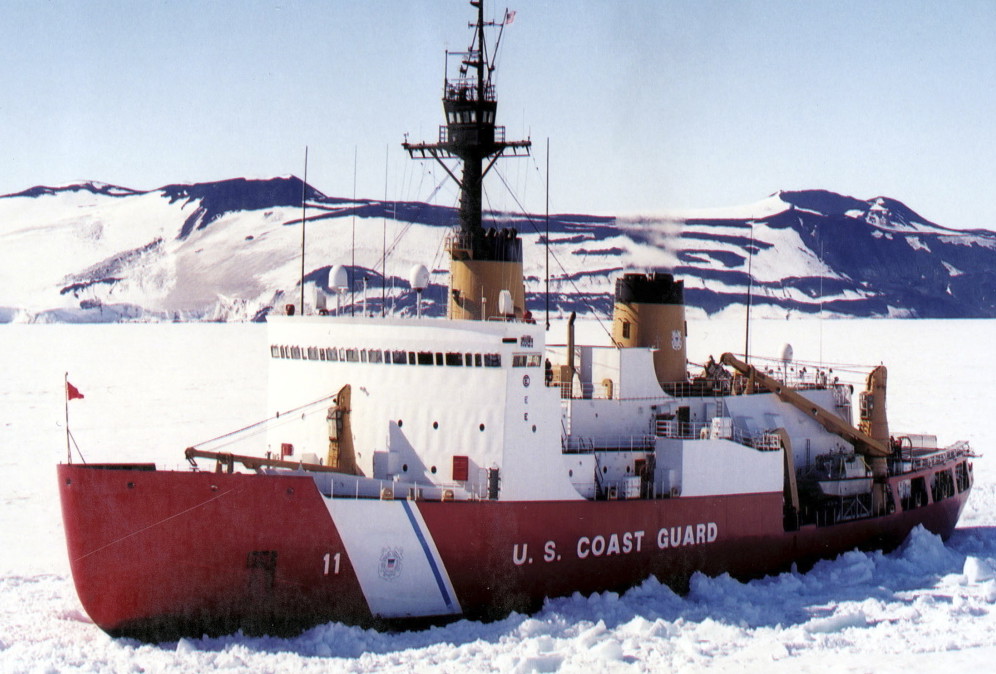Sen. Angus King of Maine is pushing to add money to the Coast Guard budget for the construction of icebreakers, saying the state’s economy would benefit if the United States had more of the ships to maintain Arctic shipping lanes.
King said icebreakers are needed to maintain shipping routes in the Northwest Passage as warming global temperatures make shipping there more feasible. Maine’s ports stand to gain because they are the closest U.S. ports to the eastern end of the passage, he said.
“This is the highway of the Arctic,” King said of the sea route through the Arctic Ocean that connects the Atlantic Ocean with Alaska’s Beaufort Sea. “It’s like not having roads if you don’t have icebreakers.”
When it comes to icebreakers, the U.S. has fallen behind other nations, especially Russia, which has 40 icebreakers plus another 11 planned or under construction.
The United States only has two fully functional icebreakers under Coast Guard command, and one of them works mostly at the other end of the globe in the Antarctic Ocean. There are three other U.S. icebreakers owned privately.
The congressional delegation in Alaska, the only U.S. state with any territory in the Arctic, has long advocated for more icebreakers. King’s involvement in the issue is welcomed by Alaskans because it makes the issue more national and less parochial, said Betsy Baker, a Vermont Law School professor who is living in Anchorage while doing research on Arctic issues.
“They appreciate any voice in Congress that highlights how important the Arctic is to the U.S.,” she said.
King, an independent, works closely on the issue with Alaska Sen. Lisa Murkowski, a Republican and co-chair of the Senate’s Arctic Caucus.
NOT YOUR AVERAGE ICE CRUNCHERS
Each icebreaker costs about $1 billion to build, King said. It’s difficult to get funding for icebreakers because the Coast Guard has a relatively small capital budget compared with the Navy or Army and already is spending a lot of money to replace cutters, he said.
In an interview Monday, King said he was pleased when President Obama announced in September that he will propose speeding up the time line for purchasing and building new Coast Guard icebreakers. Obama has yet to provide any funding details.
The icebreakers under discussion aren’t like the cutters that the Coast Guard dispatches to Maine every spring to break up ice on the state’s major rivers to prevent flooding.
The Polar Star, for example, the only heavy duty icebreaker in service, is 399 feet long and displaces about 13,200 tons. It can break through ice up to 6 feet thick.
By comparison, the Coast Guard’s new National Security Cutters – its offshore patrol vessels – are about 418 feet long but displace only about 4,000 tons.
Icebreakers don’t plow through pack ice. They use their power to push onto the ice so the weight of the ship pushes down, letting gravity do the work.
POSSIBLE BENEFITS FOR BATH IRON WORKS
King said Arctic shipping presents an opportunity for Maine’s economy in the same way that Singapore has benefited from its position as a trading hub. Portland could handle container cargo, and Eastport could handle bulk cargo, especially if it had access to rail like Portland now does, he said.
He said Icelandic shipping company Eimskip, which in 2013 made Portland its North American headquarters, gives Maine a competitive advantage over other U.S. ports.
Additionally, Bath Iron Works would be well-positioned to win a contract to build icebreakers, King said. The shipyard hasn’t built a Coast Guard vessel since the 1930s, but hopes to outbid two Gulf Coast shipyards for a project to build the offshore cutters that’s worth up to $10 billion.
Matt Wickenheiser, a spokesman for BIW, said in an email that shipyards will “certainly explore any potential opportunities offered by this future program.”
OTHER MAINE COMPANIES ALSO HAVE EXPERTISE
While it would be great if BIW landed a big contract, other Maine companies have expertise in designing and building for the marine environment and in using advanced composites technology, and they could assist in an icebreaker construction project, said Dana Eidsness, director of the state’s North Atlantic Development Office at the Maine International Trade Center.
“We have the expertise here,” Eidsness said.
She said Maine companies can gain a competitive edge if they build up their knowledge on the issue. The center is organizing a trade mission to Scandinavia next June and will be meeting with companies in Denmark that are working on designing “green ships” that pollute less than conventional freighters, Eidsness said. In preparation for that trip, the trade center is holding a forum about trade opportunities with Scandinavian nations, scheduled for Jan. 12 at the University of Southern Maine in Portland.
King, founding co-chair of the Senate Arctic Caucus, announced this year that the U.S. State Department has tapped Portland to host a meeting of the Arctic Council in 2016. That meeting, scheduled for next October, is expected to include as many as 250 delegates and Arctic experts. It is the first Arctic Council meeting in the U.S. to take place outside of Alaska.
King went to Iceland in October as part of a delegation of 45 Mainers to attend a forum on Arctic issues.
Send questions/comments to the editors.





Success. Please wait for the page to reload. If the page does not reload within 5 seconds, please refresh the page.
Enter your email and password to access comments.
Hi, to comment on stories you must . This profile is in addition to your subscription and website login.
Already have a commenting profile? .
Invalid username/password.
Please check your email to confirm and complete your registration.
Only subscribers are eligible to post comments. Please subscribe or login first for digital access. Here’s why.
Use the form below to reset your password. When you've submitted your account email, we will send an email with a reset code.